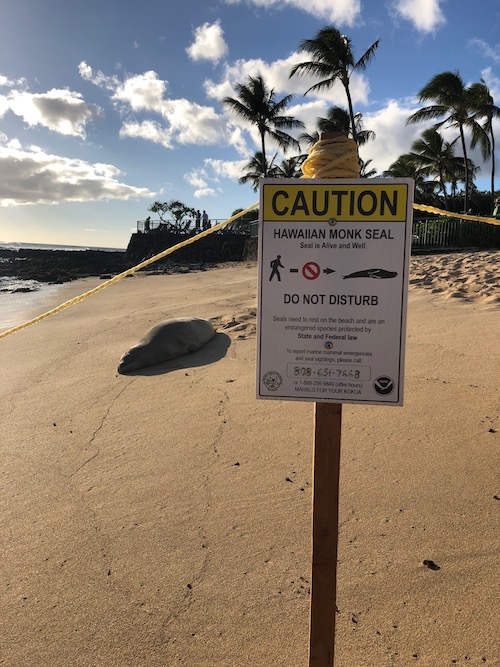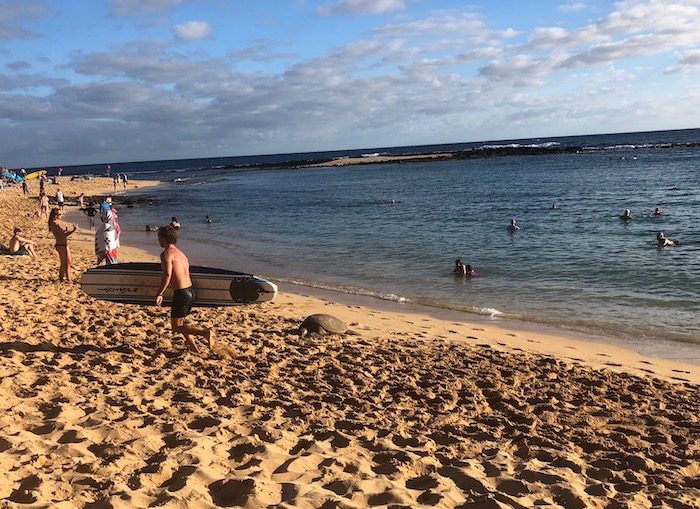
On Poipu Beach on Kauai, bikini-clad humans are sometimes joined by two endangered species: monk seals* and green sea turtles. Both are there for the same reason we are—to bask in the sun. But while the only beings taking notice of me as I lie supine on the soft beige sand are the fearless wild chickens that roam this island in search of stolen morsels of spam misubi, the turtles and seals draw a crowd of gawkers who gaze at them through their phone screens with…slightly aggressive reverence .
The monk seals have their own goons. Well, goons is perhaps a rather strong description for the amiable retirees in lawn chairs that show up when a monk seal is spotted and erect a temporary fence around the lolling pinnipeds. They pop up a sign that reassures the public that despite not moving, the “seal is alive and well.” They are stern with those who would seek to breach the fence to photograph or cuddle the seals. Of course, the seals are not without their own defenses.
“The real trouble is when people try to hug them,” one of the seal protectors told me. “That’s when people get bit.”
The turtles are a bit less extremely endangered than the monk seals, and they apparently do not rate goons. They are on their own—except for the members of the public that take it upon themselves to explain to those ignorant of the rules that it is forbidden to touch basking sea turtles or take intimate selfies with them.
I witnessed one such public lesson. A man recording a turtle with his phone circled ever closer, nearly touching it. The turtle seemed to give the man a baleful look, but to be fair, green sea turtles always seem to be giving a baleful look. It is just how their faces are built. An extremely fit and tan man in his 70s told the too-close man off. At the end of his dressing down he said, “what makes you think you’re so special?”
I silently cheered from my distant towel as the offender beat a chagrined retreat. You tell him, old man! People who touch and pick up wild animals seem to see themselves as worthy of having a ‘special’ experience but the animals as unworthy of any personal space. The people are the center of the world, the animal merely a prop for their Instagram account.
Watching people get too damn close to the turtle stressed me out. I found myself seething with anger that people didn’t instinctively give it more room. (NOAA recommends at least 10 feet of distance, which is still plenty near enough to see lots of amazing detail and feel the thrill of being close to a majestic fellow creature.) And I found myself mourning the fact that these creatures are now so rare that seeing them throws people into a tizzy.
I have been thinking a lot lately about the lost abundance of wildlife. Yes, extinctions are terrible, but we tend to focus on them to the exclusion of the extreme declines in the local abundance of species. This everyday biological poverty—which we often can’t even recognize because the declines occurred before we were born—is a loss of complexity, of vitality, of beauty. It is a symptom of our species’ almost supernatural ability to re-route the Earth’s resources into our own collective maw. Sunlight, land, fresh water, biomass—over the centuries higher and higher percentages of these necessities for life have flown towards humans and our domestic animals.
A recent look at the global weight of living things, estimated that humans are 36% of all mammals by weight, and our livestock are another 60%. Just 4% of mammals, by weight, are wild animals. 70% of all birds in the world, by weight, are chickens. These general ratios held up on Poipu Beach. There was one monk seal and one green sea turtle and approximately 100 humans and a dozen chickens.

Abundance declines are extremely depressing. But they are reversible. It is possible to imagine a world where the percentage of mammals by weight that are wild animals is much, much higher. It will take major changes in how we live, what we eat, and how we govern ourselves. But we can do it if we have the will. (And what about human population you ask? For that, I refer you to this excellent two-part Outside/In podcast series on the human population question.)
One last thought about the humans pushing too close to the seal and the turtle. It made me mad and it still does. But as I watched from a distance while the sun’s rays streamed nearly horizontally up the beach from a 5:30 PM sun, I realized that in that scrum of onlookers was a deep fascination with the nonhuman and a inchoate and misapplied urge to connect, E.M. Forster style. The people were tempted to touch because they wanted to reach out across the species divide and have some kind of relationship with these animals. Though hugging an endangered seal is not a good way to express it, the underlying urge ultimately gives me hope. The thing is to harness this urge for good, to use our desire to connect to our animal kin to help them, not smother them or frighten them. Instead of hugging a seal, we sign up to become a seal goon.
And then like a flock of starlings pivoting in the sky, the turtle gawkers broke up and drifted away while the ancient reptile dozed on. It was alone. The next people who walked by kept their distance and didn’t even photograph it. They just glanced at it semi-covertly, like New Yorkers nonchalantly spotting John Turturro at the grocery co-op. A surfer jogged by, barely breaking stride. It was a vision of a possible future—one where a basking sea turtle or napping monk seal is so common, it is just no big deal.
*This is not a story about monk seals getting eels stuck in their noses, but yes, that is a thing.